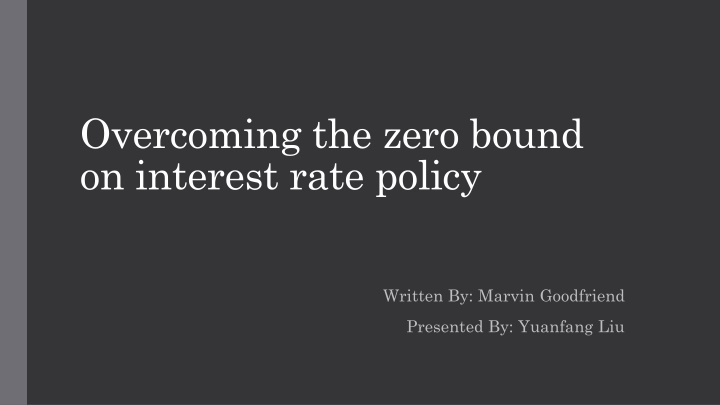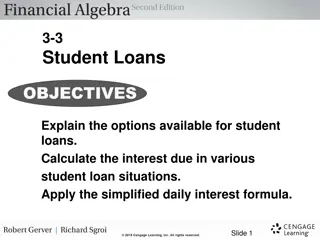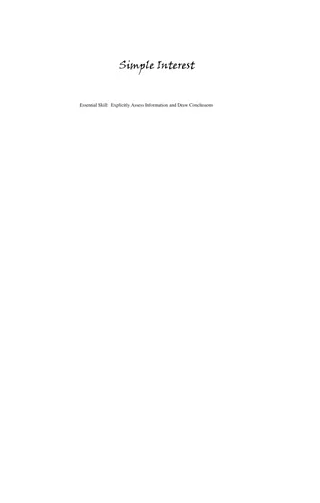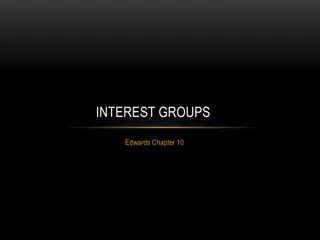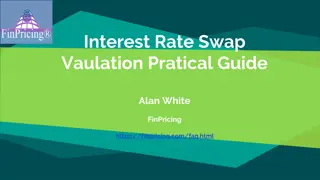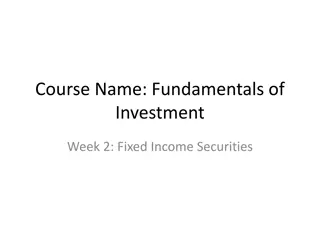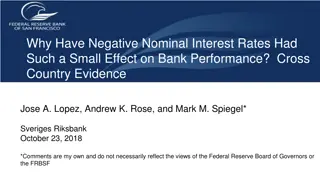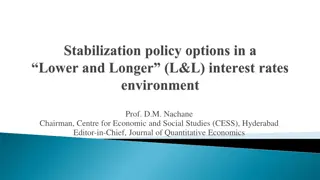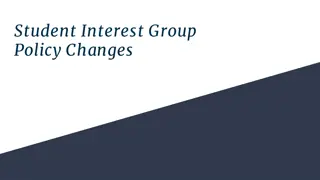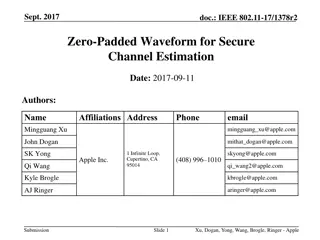Overcoming the Zero Bound on Interest Rate Policy by Marvin Goodfriend
Exploring the zero bound problem in interest rates, the paper discusses the challenges of negative nominal interest rates, their impact on the economy's stability, and proposed solutions such as carry taxes on money, open market operations, and monetary transfers. Factors affecting real interest rates, implications of deflation expectations, and forecasts for short-term interest rates are also analyzed.
Uploaded on Sep 19, 2024 | 9 Views
Download Presentation

Please find below an Image/Link to download the presentation.
The content on the website is provided AS IS for your information and personal use only. It may not be sold, licensed, or shared on other websites without obtaining consent from the author.If you encounter any issues during the download, it is possible that the publisher has removed the file from their server.
You are allowed to download the files provided on this website for personal or commercial use, subject to the condition that they are used lawfully. All files are the property of their respective owners.
The content on the website is provided AS IS for your information and personal use only. It may not be sold, licensed, or shared on other websites without obtaining consent from the author.
E N D
Presentation Transcript
Overcoming the zero bound on interest rate policy Written By: Marvin Goodfriend Presented By: Yuanfang Liu
Marvin Goodfriend Director of research and policy advisor at the Federal Reserve Bank of Richmond from 1993 to 2005. This paper was published in 2000.
What is zero bound problem Fisher pointed that if a commodity could be stored costlessly over time, then the rate of interest in units of that commodity could never fall below zero. No one will lend money at negative nominal interest if cash is costless to carry over time.
Why it is an issue Real interest rates must fluctuate to stabilize the economy over the business cycle. Negative real interest rates may have helped the economy to recover from recession in the past, particularly in the periods of financial market stress. Deflation expectations in economic downturns can actually raise expected real interest rates when nominal rates are at the zero bound, with perverse effects on demand and employment. Nominal interest rate = Real interest rate + inflation rate
Current Short-term interest rate * Graph from https://data.oecd.org/interest
2018 Short-term interest rate forecast * Graph from https://data.oecd.org/interest
Three options to overcome zero bound A carry tax on money Open market operation in long bonds Monetary transfers
A Carry Tax on Money
Imposing the Carry Tax Impose a carry tax on electronic bank reserves Good: competition among banks to avoid the carry tax would push the interbank below zero. The interbank rate would go no lower because banks would not lend reserves at a loss greater than the storage cost of electronic reserves. Bad: if carry tax is high, banks and the public would probably hoard currency rather than lend it. Impose a carry tax on vault cash and currency
Technological Feasibility Modern payments system technology makes it possible to impose and vary a carry tax on electronic bank reserves at the central bank. Whenever the intended target for the interbank interest rate reached zero, the policy committee could activate a daily tax on electronic reserve balances. A carry tax could be imposed on currency by imbedding a magnetic strip in each bill. The magnetic strip could visibly record when a bill was last withdrawn from the banking system. A carry tax could be deducted from each bill upon deposit according to how long the bill was in circulation.
Carry Tax vs. Inflation Tax What is inflation tax? Inflation tax is not an actual tax paid to the government. It is a penalty for holding cash during high inflation. Nominal interest rate = Real interest rate + Inflation rate
Carry Tax vs. Inflation Tax Carry Tax Inflation Tax Imposed temporarily Permanent distortionary No effect on the opportunity cost of holding money Permanent administrative cost involved in operating and maintaining system Effect on the opportunity cost of holding money Relative low cost
Open Market Operation in Long Bonds
Notions of Liquidity Services Narrow liquidity services: provided by the medium of exchange allowing the public to economize on shopping time in transactions. Broad liquidity services: a service yield provided by assets according to how easily they can be turned into cash, either by sale or be serving as collateral for external financing. External finance premium: imperfect information and costly enforcement of contacts created a wedge between the cost of fund raise externally and internal funds.
Banks and Open Market Purchases Banks during economy depression: Difficult to attract new borrowers without an accompanying decline in interest rates External finance premium increases and acceptable borrowers harder to find Open market purchase: Put cash in the hands of the nonbank public
Why long bond? Relative little liquidity services Open market purchases that monetize longer- term bonds when interest rates are low could increase substantially broadly defined monetary liquidity. Higher risk of capital loss Increase cost of sale More haircut off market value when used as collateral
An Adverse Aggregate Demand Shock - example Expected decline in future income Decline in firm demand for labor Households cut current consumption Firms cut current investment
Depressed Economy in Asset Markets - example Consumption spending on durables (cars and houses) Price of durables Firm profits and marginal product of capital Price of physical capital and claims to intellectual and organizational capital Also, the collapse in asset values reduces net worth, the capital of banks, and the value of collateral available for loans. This raises the external finance premium and depresses current spending further. On net, the contraction increases the demand for liquidity services broadly defined.
Monetary Transmission at the Interest Rate Floor Portfolio Rebalancing Channel Open market purchases reduce the high implicit marginal liquidity services yield on monetary assets Holders of monetary assets seek to rebalance their portfolio by acquiring less liquid assets Higher asset price
Monetary Transmission at the Interest Rate Floor Credit Channel Open market purchases reduce external finance premium Collateral value reflate, net worth increase Credit spreads narrow Spending increases because the cost of borrowing falls
Monetary Transfers Monetary transfer: to inject money directly to the public For example, monetary transfer can be achieve by cutting taxes. A central bank would transfer money to the public by buying long bonds at low or negative nominal interest and subsequently selling them back to the public with unexpected capital losses.
Two Possible Results Result 1: the economic recovery raises income and real wealth enough to absorb the monetary transfers as permanent additions to the public s desired stock of monetary asset. Result 2: the public s demand for money does not rise to absorb the monetary transfers after the economy recovers. In this case, central bank would reverse any monetary transfers expected to create inflation.
Monetary Transfer Reverse Method 1: the government could temporarily increase taxes relative to spending Method 2: the central bank could sell securities, in which case the public would receive a stream of interest payments matched by an offsetting stream of higher taxes.
Quantitative Policy Challenges Quantitative policy would lack credibility if a central bank were unable to take capital losses Quantitative policy results in a permanent increase of government debt in the hands of the public Quantitative policy would lack credibility if the country were unwilling to accept a increased government debt
How to Solve the Issue? Treasury could agree to indemnify the central bank against capital losses Treasury supports monetary policy with fiscal policy (for example, increasing government debt in the hands of the public)
Thoughts Relative applicable as of 2000 The ideas of carry tax and monetary transfer are relative creative Rich information
Thoughts This paper is aged Negative interest rate is not the best choice It is really had to decide what is the most appropriate way to impose tax or do quantitative easing Relationship between Treasury and Central Bank!
Reference Overcoming the Zero Bound on Interest Rate Policy Source: Journal of Money, Credit and Banking, Vol. 32, No. 4, Part 2: Monetary Policy in a Low-Inflation Environment (Nov., 2000), pp. 1007-1035 Published by: Ohio State University Press Stable URL: http://www.jstor.org/stable/2601157
